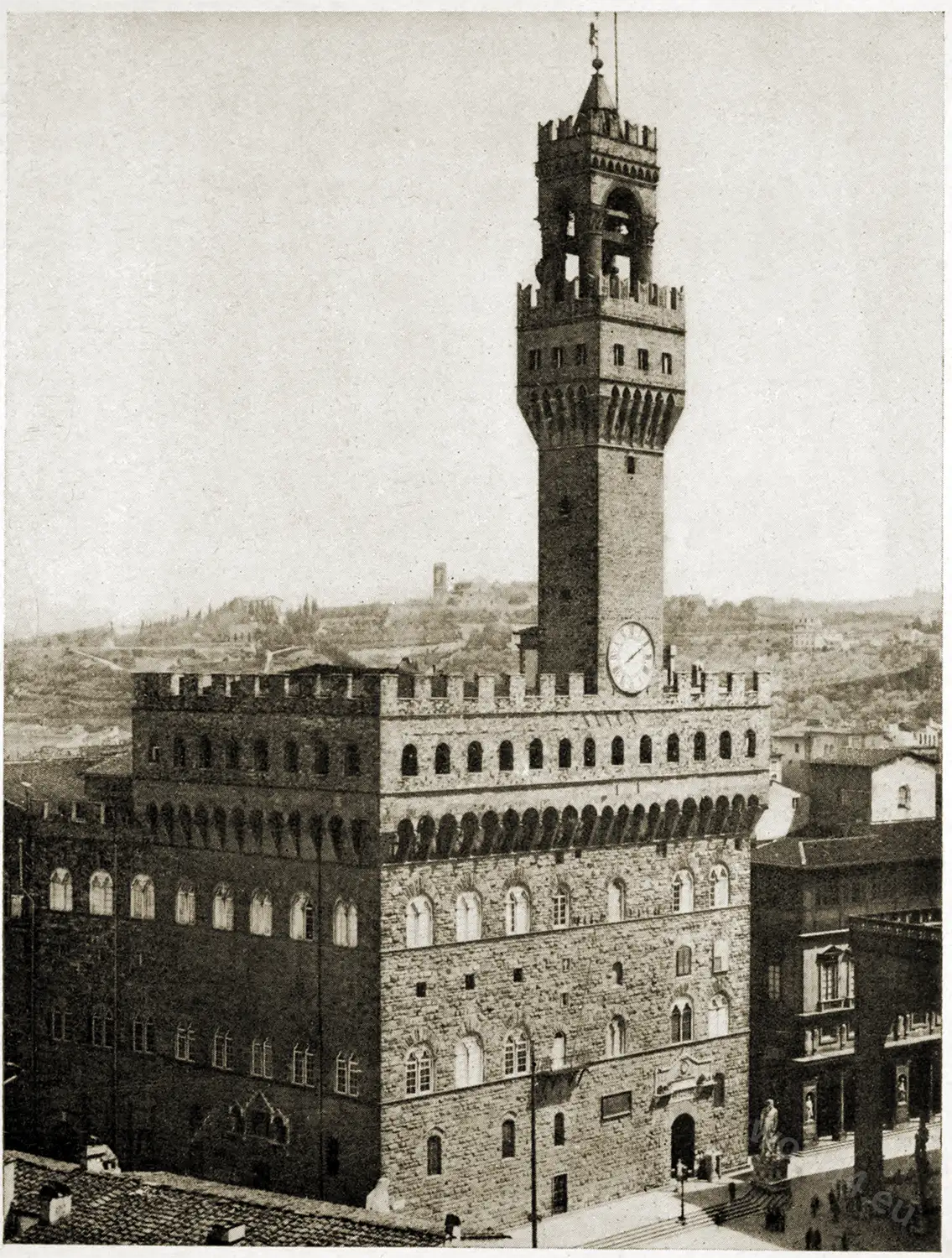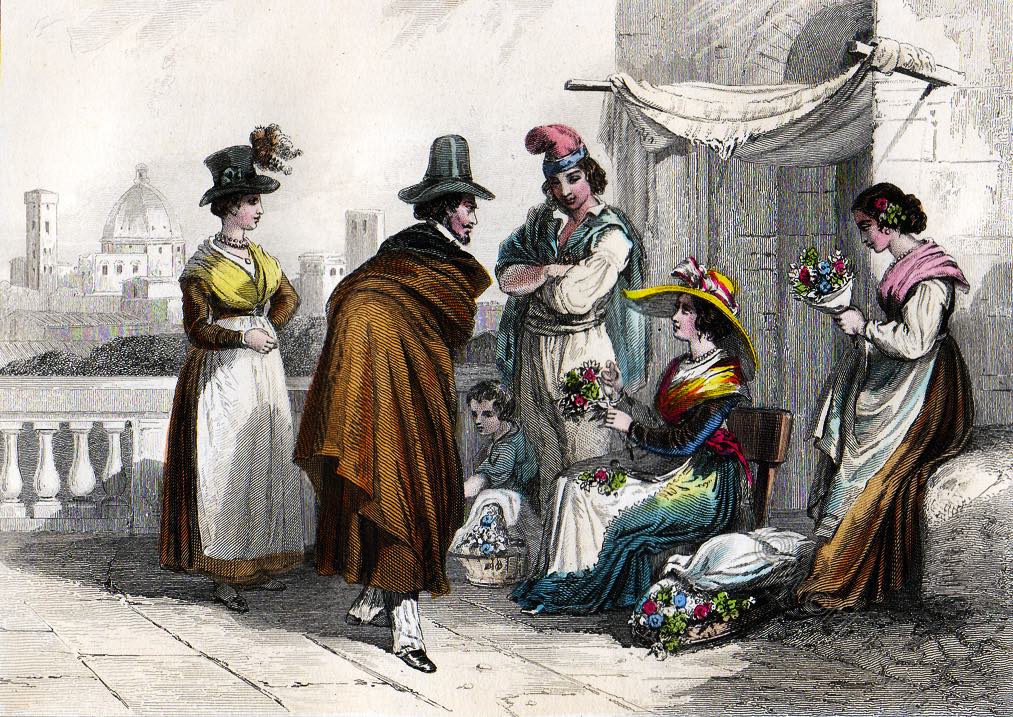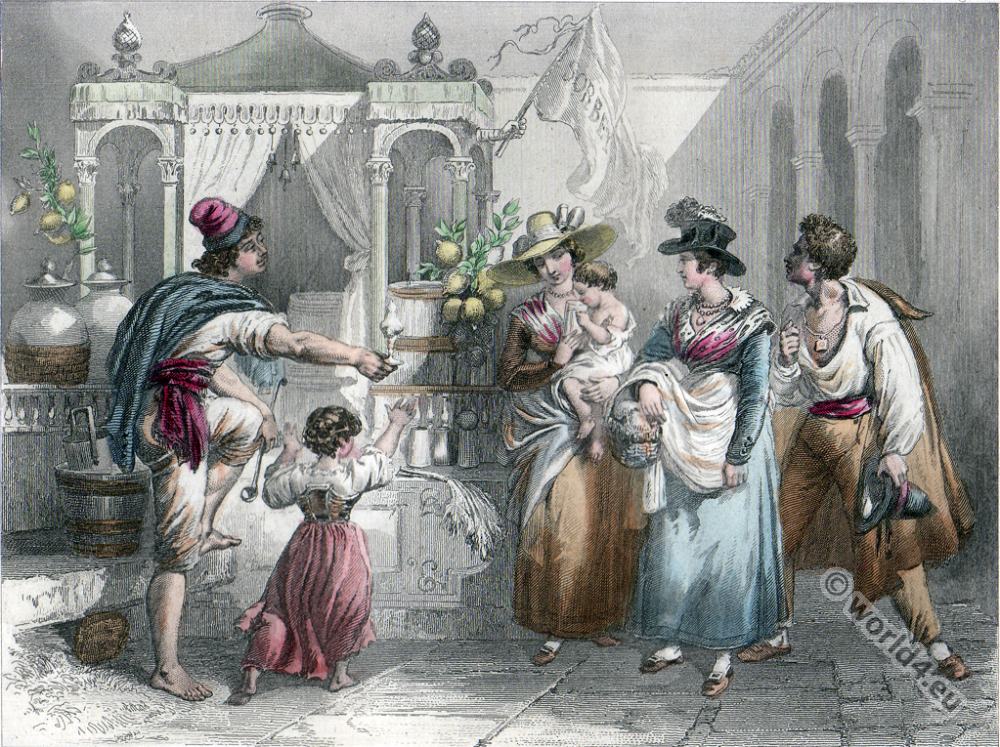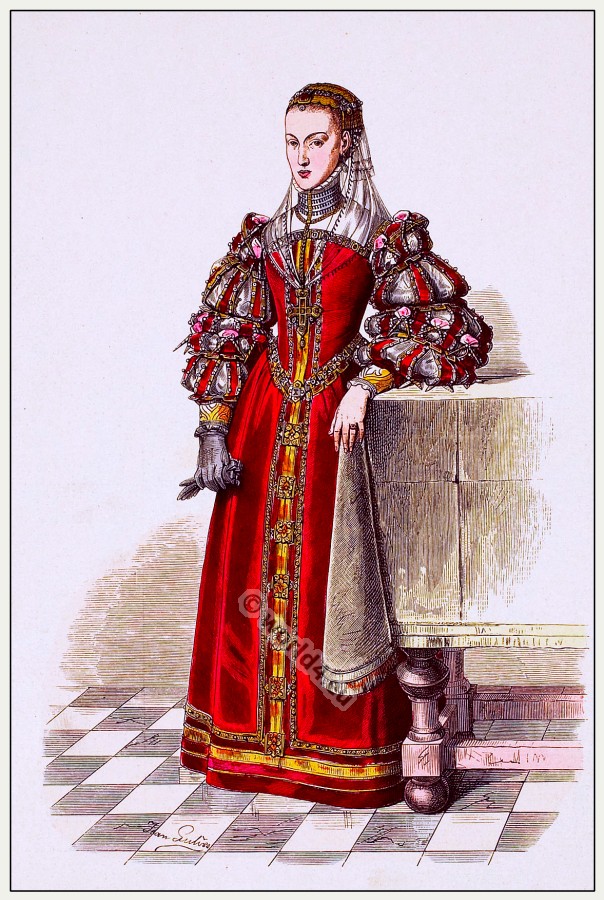The Palazzo Vecchio (“old palace”), as the seat of the city parliament, represented the center of secular power in 14th century Florence. Completed in 1314, it was originally called Palazzo della Signoria (the Signoria was the government of the Republic) until the administration moved to the Uffizi under Duke Cosimo I of the House of Medici.
Palazzo Vecchio
by ALEXANDRE DUMAS.
GRAND as was the idea I had formed in advance of the Palazzo Vecchio, I must confess that the realization was still grander. When I saw that mass of stone so strongly rooted in the ground, surmounted by its tower that threatens the heavens like the arms of a Titan, the whole of old Florence, with her Guelphs, her Ghibellines, her balie, her priors, her lords, her guilds, her condottieri, her turbulent mobs and her haughty aristocracy appeared to me as though I were about to take part in the exiling of Cosmo the Elder, or in the execution of Alviati. In fact, four centuries of history and art are there on the right, on the left, in front and behind, surrounding you on all sides and speaking at once with their stone, marble and bronze of Nicholas d’Uzzano, Orcagna, Rinaldo d’Albizzi, Donatello, Pazzi, Raphael, Lorenzo de’ Medici, Flaminius Vacca, Savonarola, John of Bologna, Cosmo I. and Michelangelo.
The whole world may be searched in vain for a spot that brings such names together, without counting those I have omitted! and some of the omissions include Baccio Bandinelli, Ammanato, and Benvenuto Cellini.
I should much like to reduce this magnificent chaos to some sort of order and chronologically classify the great men, the great works and the great memories, but that is impossible. When you arrive at this wonderful square, you must go where the eye carries you, or where instinct guides you.
What first engrosses the attention of the artist, the poet, or the archæologist, is the sombre Palazzo Vecchio, still blazoned with the ancient arms of the republic, amid which glitter on the azure, like stars in the sky, those innumerable fleurs-de-lys sown along the road to Naples by Charles of Anjou.
Florence was hardly free before she wanted to have a town hall as an abode for a chief magistrate and a belfry for calling the people together. When a community is constituted in the North, or a republic established in the South, the desire for a town-hall and a belfry is always the first operation of its will, and the satisfaction of that desire the first proof of its existence.
Thus in 1298, that is to say only sixteen years after the Florentines had conquered their constitution, Arnolfo di Lapo received from the rulers the order to build a palace for them.
Arnolfo di Lapo had visited the site reserved for him and had prepared his plans accordingly. But at the moment of laying the foundations of his edifice, the people loudly forbade him to place a single stone upon the spot where the house of Farinata des Uberti had stood. Arnolfo di Lapo was forced to bow to this popular clamour; he pushed his edifice back into a corner and left the accursed spot unoccupied. Even to the present time neither stones nor trees have planted their roots there and nothing has intruded for more than six centuries where Guelph vengeance drove the plough and sowed with salt.
This palace was the residence of a standard-bearer and eight priors, two for each quarter of the city; their charge lasted for sixty days and during that time they lived together, eating at the same table and not being able to leave their residence: that is to say, they were almost prisoners. Each had two domestics to serve him and there was always a notary at their orders ready to write down their deliberations: he ate with them and was a prisoner like themselves. As a recompense for the sacrifice of his time and liberty that each prior made for the republic, he received ten pounds a day, or nearly seven francs of our money. At that day, private parsimony ruled in public economy, and the government thus found itself in a position to execute great things in art and in war. Thence resulted its surname of the Magnificent Republic.
You enter the Palazzo Vecchio by a door situated about a third of the way along the front and find yourself in a little square court, surrounded by a portico supported by nine columns of Lombard architecture embellished with applied ornaments. In the centre of this court is a fountain surmounted by a rococo Cupid holding a fish and reposing on a porphyry basin. At the time of Ferdinand’s marriage this portico was adorned with fresco paintings representing bird’s-eye views of the cities of Germany.
On the first floor is the great Council Hall, executed by the orders of the Republic and at Savonarola’s suggestion. A thousand citizens could deliberate there at their ease. Cronaca was the architect, and he pushed the work so rapidly that Savonarola used to say that the angels served as his masons.
Cronaca had need of haste, for three years later Savonarola was to die and thirty years afterwards the Republic was to fall.
Therefore this immense hall has retained nothing of that period but its original form: all of its ornamentation belongs to the time of the principality; its frescoes and ceiling are by Vasari; its pictures by Cigoli, Ligozzi and Passegnano; and its statues by Michelangelo, Baccio Bandinelli and John of Bologna.
All to the great glory of Cosmo I.
In fact, Cosmo I. is one of those gigantic statues that history raises like a pyramid to mark the limit where one era ends and another begins. Cosmo I. is at the same time the Augustus and the Tiberius of Tuscany, and this is so much the more true in that at the moment when Alexander fell beneath the poniard of Lorenzino, Florence found herself in the same situation as Rome was after Cæsar’s death: “There was no longer a tyrant, but there was no longer any liberty.”
At fifteen years of age his character was already outlined and those who approached him could form an idea of what he would be later. His appearance was grave and even severe; he was slow to form familiar relations and would seldom allow any formalities; but when he granted this double concession it was a proof of his friendship, and his friendship was sure; nevertheless, even with his friends he was discrete in all his actions and did not want any one to know what he intended to do until it was done. The result was that he always seemed to be seeking some end contrary to his real one, which always rendered his answers brief and sometimes obscure.
This was Cosmo when he learnt the news of the assassination of Alexander and the flight of Lorenzino; this flight left him without a competitor for the princedom and therefore his measures were quickly taken. He gathered together a few friends on whom he could depend, mounted his horse, and set out for Florence.
Cosmo was rewarded for his confidence by the welcome that he received: he entered the city amid the joyous acclamations of all the inhabitants. Two days after, he was named chief and governor of the republic on four conditions:
To dispense justice indifferently to the rich and to the poor.
Never to consent to restore the authority of Charles the Fifth.
To avenge the death of Duke Alexander.
To treat well Giulio and Giula, the natural children of the latter.
Cosmo accepted this species of charter with humility and the people accepted Cosmo with enthusiasm. But there happened to the new grand duke what happens to all men of genius who are raised to power by revolution. On the lowest step of the throne they receive laws, from the top step they impose them.
The position was difficult, particularly for a youth of eighteen. It was necessary to fight external and internal foes at the same time; to substitute a firm government, a single power and a durable will for all those flabby or tyrannical governments, for all those powers that were opposed and consequently destructive to one another, and for all those wills which sometimes starting from above and sometimes from below caused a perpetual ebb and flow of aristocracy and democracy upon which it was impossible to establish anything solid and durable. And yet with all that it was necessary so to manage the liberties of this people that neither nobles, citizens, nor artisans might feel the master. In fact it was necessary to manage this horse, that was still rebellious under tyranny, with an iron hand beneath a silken glove.
Cosmo was in every respect the man needed to carry through such a work. As dissimulating as Louis the Eleventh, passionate as Henry the Eighth, brave as Francis the First, persevering as Charles the Fifth and magnificent as Leo the Tenth, he had all the vices that make private life sombre and all the virtues that make public life brilliant. Therefore his family was unhappy and his people happy.
Cosmo was one of most learned men of his time. Among other things he knew a great number of plants and the places where they grew, where they lived the longest, where they had the strongest scent, where they produced the most beautiful flowers, or bore the finest fruits, and what were their virtues for curing the diseases or wounds of men and animals; then, as he was an excellent chemist, with the plants he made waters, essences, oils, medicaments, and balms, and gave his remedies to all who asked for them whether they were rich or poor, Tuscan subjects or foreigners, inhabitants of Florence or any other part of Europe.
Cosmo loved and protected letters. In 1541 he founded the Florentine Academy which he called his “very dear and happy Academy”: Plutarch and Dante were read and commented on there. The sessions were first held in the Via Larga Palace and afterwards, so that it might have more ease and freedom, he gave it the great council-room in the Palazzo Vecchio. After the fall of the republic this great hall had become useless.
Cosmo was an artist and it was not his fault if he arrived at the moment when great men were departing. Of all that brilliant galaxy that had illuminated the reigns of Julius the Second and Leo the Tenth, Michelangelo alone remained. He did everything he could to get the latter: he sent a cardinal and an embassy offering him any sum of money he might name, the title of senator and any office he wished; but Paul the Third kept him and would not give him up. Then, in default of the Florentine giant, he gathered together the best he could find.
Ammanato, his engineer, built for him the fine bridge of the Trinity after the plans of Michelangelo, and carved for him the marble Neptune in the Palazzo Vecchio Square. He made Baccio Bandinelli produce the statues of Pope Clement the Seventh, Duke Alexander, Giovanni de’ Medici, his father, 48 and his own statue; the Loggia of the Mercato Nuovo and the choir of the Cathedral. Benvenuto Cellini was recalled from France to cast his Perseus in bronze, to carve agate cups and to engrave gold medals for him. Then as there had been found in the environs of Arezzo a lot of little bronze figures, some of which lacked the head, others the hands, and others the feet, Cosmo cleaned them himself and carefully removed the rust so that they might not be damaged.
By means of his chemical researches, Cosmo, with Francesco Ferruci of Fiesole, recovered the art of cutting porphyry, which had been lost since Roman times.
Lastly, he brought together in the Via Larga and Pitti Palaces all the pictures, statues and medals, whether ancient or modern, that had been painted, carved, engraved or discovered in excavations by Cosmo the Elder, Lorenzino, and Duke Alexander, and that had twice been pillaged and dispersed: — first, when Charles VIII. passed through, and again at the assassination of Duke Alexander by Lorenzino.
Therefore the praise of his contemporaries outweighed the blame of posterity: the dark side of his life was lost in the brilliant side, and people forget that this protector of art, science and literature slew one son, poisoned one daughter and violated another.
We see then that there was something of both Augustus and Tiberius in Cosmo I.
Now let us return to the hall of the Palazzo Vecchio. The picture, not the most remarkable from an artistic point of view, but certainly the most extraordinary as a recorded fact, is one by Ligozzi representing the reception given by Boniface VIII. to twelve ambassadors of twelve powers, who were all found to be Florentines; so incontestable throughout the world was the political genius of the Magnificent Republic during the Thirteenth and Fourteenth Centuries.
These twelve ambassadors were:
Muciato Franzizi for the King of France.
Ugolino di Vicchio for the King of England.
Raneire Langru for the King of Bohemia.
Vermiglio Alfani for the King of the Germans.
Simone Rossi for Rasca.
Bernardo Ervai for the Lord of Verona.
Guicardo Bastai for the Khan of Tartary.
Manno Fronte for the King of Naples.
Guido Tabanca for the King of Sicily.
Lapo Farinata des Uberti for Pisa.
Gino di Ditaselvi for the lord of Camerino.
Bencivenni Folchi for the Grand Master of the Hospital of Jerusalem.
It was this strange gathering that made Boniface VIII. say that a fifth element had come into the world, and that the Florentines constituted this element.
The enormous frescoes that cover the walls, as well as all the pictures on the ceiling, are by Vasari. The frescoes represent the wars of the Florentines against Siena and Pisa. It was for the latter that Michelangelo prepared those beautiful cartoons that disappeared without any one knowing what had become of them.
In the other chambers of the palace, which are the living-rooms, there are also a considerable number of paintings of almost the same period. One exception is a charming little chapel by Rodolfo Guirlandaio, the restrained and religious execution of which forms a strange contrast to the facile and pagan painting of the beginning of the Decadence.
Entirely upset as it was by the arrangements of Cosmo I., the Palazzo Vecchio yet materially preserves one memory of the Republic: this is the Barberia Tower in which Cosmo the Elder was confined, and at the door of which, later during the Pazzi conspiracy, the brave standard-bearer, Cesare Petrucci, mounted guard with a spit. In this tower, Cosmo the Elder spent what were certainly the four worst days of his long life, the fear of being poisoned by his enemies preventing him from taking any nourishment.
Source: Romantic castles and palaces as seen and described by famous writers by Esther Singleton (1865-1930, American author and journalist). New York, Dodd, 1911.
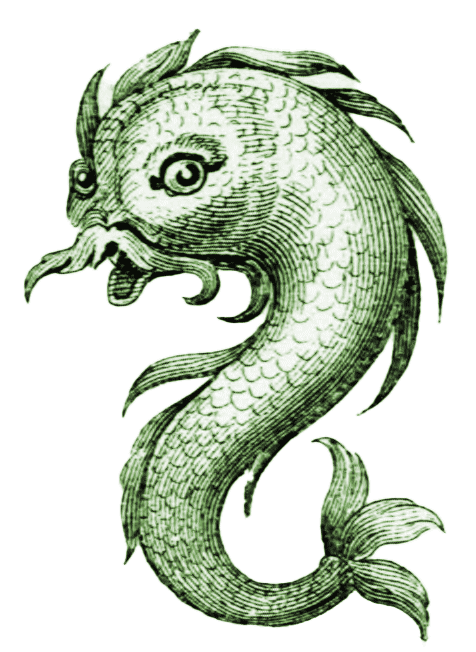
Discover more from World4 Costume Culture History
Subscribe to get the latest posts sent to your email.

